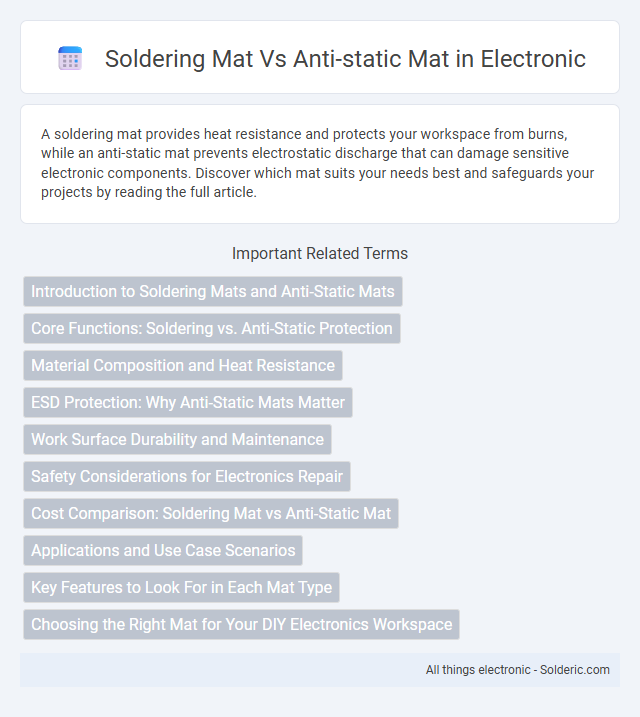A soldering mat provides heat resistance and protects your workspace from burns, while an anti-static mat prevents electrostatic discharge that can damage sensitive electronic components. Discover which mat suits your needs best and safeguards your projects by reading the full article.
Comparison Table
| Feature | Soldering Mat | Anti-Static Mat |
|---|---|---|
| Primary Use | Protects work surface from heat and solder spills | Prevents electrostatic discharge (ESD) damage to electronic components |
| Material | Heat-resistant silicone or rubber | ESD-safe vinyl or rubber with conductive layers |
| Heat Resistance | High (up to 500degC) | Low to moderate, not designed for heat exposure |
| Electrostatic Protection | Minimal or none | Essential, dissipates static charges safely |
| Surface Texture | Flat or with compartments for tools | Usually smooth and uniform |
| Common Users | Electronics hobbyists, soldering professionals | Electronics assembly, repair technicians |
| Price Range | Moderate ($10 - $30) | Moderate to high ($15 - $50) |
| Durability | Long-lasting under heat exposure | Durable under static-safe conditions |
Introduction to Soldering Mats and Anti-Static Mats
Soldering mats provide a heat-resistant surface designed to protect your workspace from high temperatures and solder splashes, ensuring safe and efficient electronics assembly. Anti-static mats, on the other hand, are engineered to dissipate electrostatic discharge (ESD) that could damage sensitive electronic components during handling and repairs. Choosing the right mat safeguards both your work area and your valuable electronic devices by addressing these distinct protective needs.
Core Functions: Soldering vs. Anti-Static Protection
Soldering mats primarily provide heat resistance and surface protection during soldering tasks, preventing damage to workbenches from high temperatures and solder splashes. Anti-static mats focus on dissipating electrostatic discharge (ESD) by grounding sensitive electronic components, reducing the risk of static damage. While soldering mats enhance thermal safety, anti-static mats safeguard electronic circuits from static electricity hazards.
Material Composition and Heat Resistance
Soldering mats are typically made from high-temperature silicone or fiberglass materials designed to withstand temperatures up to 500degF (260degC), providing excellent heat resistance during soldering tasks. Anti-static mats, on the other hand, are constructed with carbon-impregnated rubber or vinyl compounds that offer electrostatic discharge (ESD) protection but generally have lower heat tolerance, often around 140degF (60degC). Choosing the right mat depends on prioritizing either thermal resilience for soldering processes or static control for sensitive electronic components.
ESD Protection: Why Anti-Static Mats Matter
Anti-static mats provide critical ESD protection by safely dissipating static electricity, preventing damage to sensitive electronic components during soldering. Soldering mats primarily offer heat resistance and workspace organization but lack sufficient electrostatic discharge control. Protecting your devices requires using anti-static mats to minimize the risk of costly static-related failures in electronic assembly and repair.
Work Surface Durability and Maintenance
Soldering mats are typically made from heat-resistant silicone, providing excellent durability against high temperatures and molten solder, making them ideal for frequent soldering tasks. Anti-static mats, constructed with conductive materials, focus on dissipating electrostatic discharge to protect sensitive electronics but may require more careful cleaning to maintain their static-dissipative properties. Your choice should balance the need for a robust, heat-tolerant work surface with the importance of static protection based on your specific workspace demands.
Safety Considerations for Electronics Repair
Soldering mats provide heat resistance and protect surfaces from molten solder, while anti-static mats are designed to dissipate static electricity, preventing electrostatic discharge (ESD) that can damage sensitive electronic components. For electronics repair, using an anti-static mat is crucial to safeguard delicate circuits and integrated chips from ESD hazards, whereas soldering mats ensure thermal safety during component soldering. Combining both mats or choosing an ESD-safe soldering mat offers optimal protection by addressing electrical and thermal safety concerns simultaneously.
Cost Comparison: Soldering Mat vs Anti-Static Mat
Soldering mats typically cost less than anti-static mats due to their simpler heat-resistant materials, making them a budget-friendly option for basic soldering tasks. Anti-static mats, designed to protect sensitive electronics from electrostatic discharge, often incorporate specialized conductive layers that increase their price. Your choice depends on whether you prioritize cost savings or electrostatic protection for your electronics projects.
Applications and Use Case Scenarios
Soldering mats are designed with heat-resistant silicone surfaces, ideal for protecting workbenches during electronics soldering and rework tasks, preventing damage from hot tools and molten solder. Anti-static mats feature conductive materials that dissipate electrostatic discharge (ESD), crucial for handling sensitive electronic components in environments such as assembly lines and repair stations. Both mats enhance workspace safety and efficiency, with soldering mats focusing on thermal protection and anti-static mats ensuring component integrity through ESD control.
Key Features to Look For in Each Mat Type
Soldering mats should have heat resistance above 500degF, non-slip surfaces, and compartments for tool organization to enhance precision and safety during electronic assembly. Anti-static mats require electrostatic discharge (ESD) protection with a resistance range of 105 to 1012 ohms to prevent damaging sensitive components, along with grounding cords and durable materials. Both mat types benefit from easy-to-clean surfaces and chemical resistance to withstand frequent use in various workspace environments.
Choosing the Right Mat for Your DIY Electronics Workspace
Selecting the right mat for your DIY electronics workspace depends on the specific tasks and safety requirements; soldering mats are designed with heat-resistant silicone to protect surfaces from high temperatures during soldering, while anti-static mats are engineered to dissipate static electricity and prevent electrostatic discharge that can damage sensitive electronic components. Prioritize a soldering mat if your focus is on thermal protection or integrating a heat-resistant workspace, whereas an anti-static mat is essential when handling static-sensitive devices like microchips or circuit boards. Combining both features in a dual-function mat offers comprehensive protection, enhancing safety and efficiency in intricate electronics assembly and repair projects.
Soldering mat vs anti-static mat Infographic

 solderic.com
solderic.com